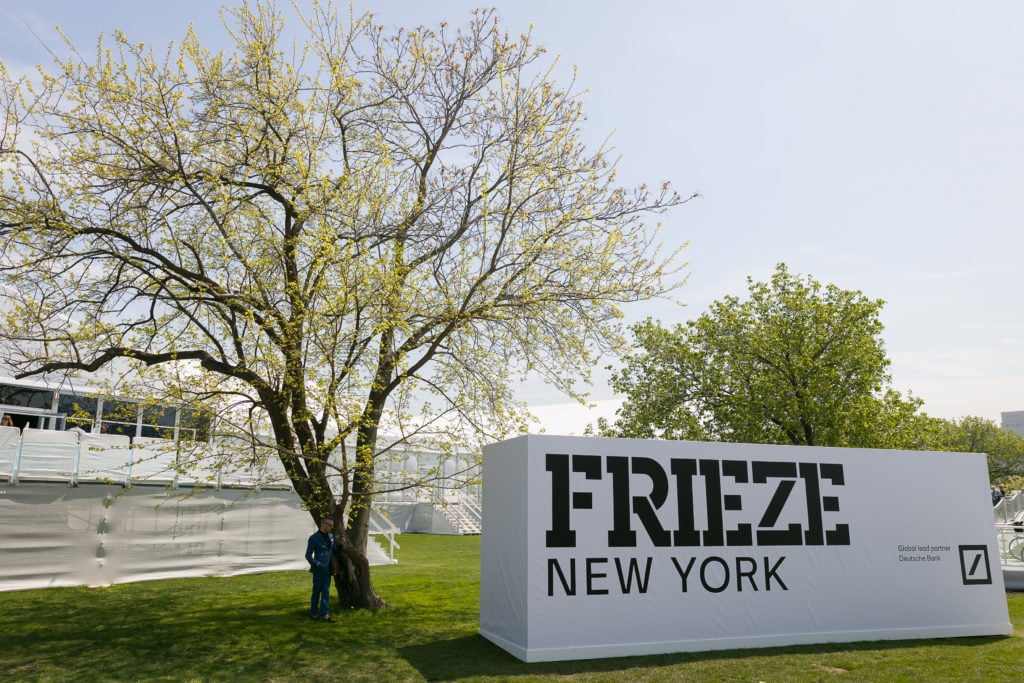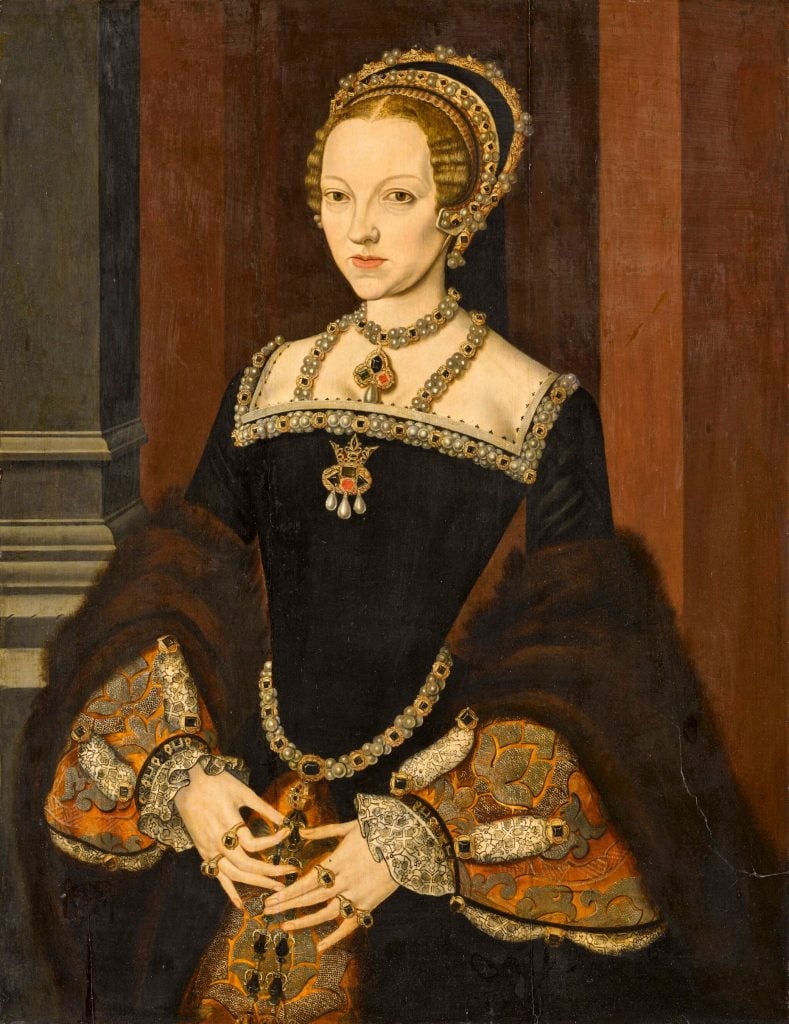The Back Room
The Back Room: Great American Frieze
This week: Frieze’s bold U.S. expansion, breaking up (a gallery) is hard to do, and much more.

This week: Frieze’s bold U.S. expansion, breaking up (a gallery) is hard to do, and much more.

Artnet News

Every Friday, Artnet News Pro members get exclusive access to the Back Room, our lively recap funneling only the week’s must-know intel into a nimble read you’ll actually enjoy.
This week in the Back Room: Frieze’s bold U.S. expansion, breaking up (a gallery) is hard to do, a royal surprise at Sotheby’s London, and much more—all in a 7-minute read (1,874 words).
_____________________________

The outside of Frieze New York 2019. Photo: Mark Blower, courtesy of Frieze.
The art industry barreled into the latest hard turn of its consolidation derby Thursday morning, as Frieze announced that it had acquired the Armory Show and signed a deal to acquire Expo Chicago later this quarter. Financial terms of the transactions were not disclosed.
Where the race goes from here is another matter entirely. In the wake of the news, here’s your Back Room primer on what’s known, what isn’t, and what we should keep an eye on in the months ahead…
What Will Stay the Same?
According to a press statement, Frieze plans to keep the following components of their two newest acquisitions unchanged…
What Will Change?
Four of Frieze’s seven annual art fairs will now take place on American soil. (The ratio rises to four of six if you count Frieze London and Frieze Masters, held concurrently a short walk from one another every October, as a single event.) That’s a significant geographical tilt for British-born Frieze.
Statements from key players also underscore a shared belief that the deals will give all involved the best of both worlds. Frieze, a global brand, gets to extend what Fox called “the depth and breadth of [its] presence in the U.S.” via closer ties to the “distinct ecosystem of artists, galleries, museums, and collectors” in NYC and Chicago.
Armory and Expo, on the other hand, should benefit from a newfound ability to “leverage a respected brand, deep industry knowledge, expanded resources, and a larger network,” Berry said in part.
What’s the Best Precedent for Frieze’s Moves?
MCH Group’s two-year investment spree in regional art fairs. But even here, we should be conscious of some important differences.
Between September 2016 and July 2018, Art Basel’s Swiss parent company acquired majority stakes in the India Art Fair and Masterpiece London, announced plans to launch the Art SG fair in Singapore (in cooperation with Sandy Angus and Tim Etchells), and took a minority stake in Art Düsseldorf. But the strategy was short-lived.
By November 2018, MCH Group announced it “would not proceed” with Art SG, and would sell its shares in the India Art Fair and Art Düsseldorf. Although MCH eventually bought back a 15 percent stake in Art SG in 2022, leadership permanently folded Masterpiece London early this year, citing insufficient demand from dealers amid rising costs and complications post-Brexit.
Those outcomes don’t necessarily mean anything vis-à-vis Frieze’s American growth plan, however.
It’s no snub of Armory or Expo to call them regional events. (Berry herself has defined the Armory Show as “quintessentially a New York fair.”) But they are regional events in the single largest, most robust art market on the planet.
That positioning contrasts sharply with MCH Group’s four regional acquisition targets, each of which was rooted in a different country with a vastly different commercial ceiling. Of the quartet, only the U.K. has an art market of global consequence—and circumstances there have undoubtedly degraded since 2016.
By the end, Masterpiece London was also as much an antiquities, rare minerals, and fossils fair as it was an art fair. Any comparison to the Armory Show, a contemporary art fair through and through, would be superficial at best. I suspect Chicago and its art industry would like a strong word with anyone keen to parallel the Windy City to Düsseldorf or New Delhi, too.
In that sense, Frieze’s regional expansion only matches MCH Group’s ill-fated one at a glance. And looking to hugely imperfect analogues for guidance is much less valuable than looking at an acquisitions’ own parameters, merits, and execution.
___________________________________________________________
The multimillion-dollar question is how Frieze’s U.S. expansion will impact the actions of dealers and collectors, particularly American ones. Undergirding this larger query are numerous smaller but still vital issues…
It’s far too soon to know any of the answers. But hey, at least now you’re better equipped to hold court on the subject at your next art world cocktail party.
_________________________________________________________
The latest Wet Paint tracks how to sort the pecking order among some of the undersung heroes of the art world: registrars, plus the Roth Bar’s triumphant return to Hauser and Wirth’s New York headquarters.
Here’s what else made a mark around the industry since last Friday morning…
Auction Houses
Galleries
Institutions
Tech and Legal News
_________________________________________________________
“I think making sure you keep a level head is important. Focus on positive things and rebuilding. Don’t fight with the ex-partner; that is what lawyers are for.”
—Dealer Rob Dimin of Dimin gallery, offering advice on how to handle a professional breakup. Dimin split with Elizabeth Denny, his longtime business partner in the now-defunct Denny Dimin Gallery, in December 2022. (Artnet News)
____________________________________________________________

Attributed to Master John, Portrait of Katherine Parr (1512–1548), Queen of England and Ireland (1544–1545). Courtesy of Sotheby’s.
____________________________________________________________
Date: ca. 1547–48
_____________________________________________________________
Seller: Estate of George Francis Child-Villiers
_____________________________________________________________
Estimate: £600,000 to £800,000 ($762,485 to $1 million)
_____________________________________________________________
Selling at: Sotheby’s London
_____________________________________________________________
Sale price: £3,436,000 ($4,366,501)
This portrait of Katherine Parr, the first Queen of both England and Ireland, fetched more than 4X its £800,000 ($1 million) high estimate after fees at Sotheby’s evening sale of Old Master and 19th Century Paintings in London on July 5. While it was not the auction’s highest-earning lot, it was easily the best-performing relative to expectations.
That wasn’t the only way in which the painting shocked the art trade, however. According to Sotheby’s, British historian Roy Strong incorrectly reported in his 1969 book Tudor and Jacobean Portraits that the painting had been “destroyed by fire.” Instead, it returned to the market unscathed through the estate of George Francis Child-Villiers, the Earl of Jersey, almost 200 years after its last appearance at auction.
Attributed to Master John, the portrait was most likely painted shortly after the 1547 death of King Henry VIII, who had made Parr his sixth and final wife four years earlier. It is one of only two portraits of her known to have survived to the present day; the other is a full-length canvas, also credited to Master John, and residing in the permanent collection of London’s National Portrait Gallery. The results prove once again that history plus intrigue plus extreme scarcity is a pretty good equation for generating a bidding war.
—Tim Schneider
________________________________________________________